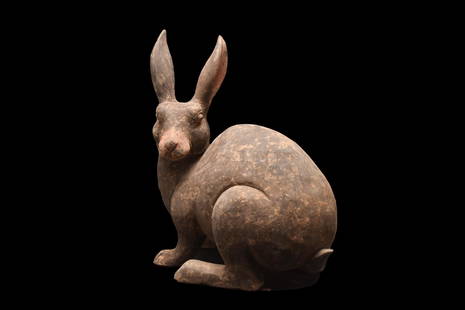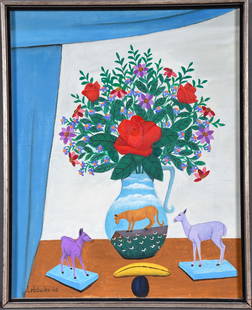
A PRE COLOMBIAN GOLD MOCHE NOSE ORNAMENT DEPICTING SHAMAN, CIRCA 800-1200 A.D
Similar Sale History
View More Items in Figurines & StatuettesRelated Figurines & Statuettes
More Items in Figurines & Statuettes
View MoreRecommended Decorative Objects
View More


Item Details
Description
A PRE COLOMBIAN GOLD MOCHE NOSE ORNAMENT DEPICTING SHAMAN, CIRCA 800-1200 A.D
Diameter: 12cm
Weight: 25 grams
Provenance: Property of a Dutch Gentleman The P. Splitt Collection, Germany, acquired in 2005 to 2010. Formerly in a Private Spanish Collection, M. J. Mosquera, acquired in the 1970's, sold in 2005.
Catalogue note: Nose ornaments made of precious metals were worn by the elite in Peru beginning in the middle of the first millennium B.C.; they remained in fashion for over a thousand years, until about 700 A.D. Among the Moche people of the north coast, they were an essential part of royal costume. This handsome crescent is made of gold and found between Chiclayo and Trujillo, probably Cayaltí or Chepen, Lambayeque, Peru. Moche metalworkers often combined two metals on fancy ornaments. In addition to the aesthetic appeal, joining gold and silver may have had symbolic meaning, perhaps expressing ideas of duality and complementarity. Particularly this type is made of an gold alloy from a mix of (Ag) gold, (Ag) Silver and (Cu) copper as main components. Only King's and religious figures of high status wore such adornments. Pre-Colombian artisans excelled in metalwork; gold, silver and copper funerary masks plundered from ancient tombs give witness to their skill and taste. The quality is so high that the image could have been pressed in and hammered over leather molds. Moche was a powerful ancient state on the north coast of present- day Peru. The Nose Ornament in Moche The Society One of the most important pieces of jewelry was the nose ring, or narigurea. Up to 4 inches wide, they were hammered down to featherweight thinness. The ring on top of the decoration was open, so it would painlessly attach onto the external naris, the piece of skin just below the nasal vestibule, which separates the nostrils. In the market places (tiangues), jewelry merchants (mindalaes) sold their wares after having traversed trade networks with neighboring peoples. This exchange of ideas resulted in each culture developing its own distinct design. Artists forged a great metallurgical tradition, making cast and hammered objects for elite use. Thousands of gold objects like nose rings, ear ornaments, lip plugs, tweezers, and figurines have been found in ancient tombs. The American Museum of Natural History had a whole collection pinned to one board. Some tribes made jewelry with wires, shaped by hammering. Tiny spheres of metal were joined by complex soldering or sweat-welding techniques to achieve delicate filigree and granulated effects. Other tribes created jewelry in simple, spherical shapes. Metalworking Repoussé or repoussage is a metalworking technique in which a malleable metal (such as gold leaf) is ornamented or shaped by hammering from the reverse side. Chasing is the opposite technique to repoussé, and the two are used in conjunction to create a finished piece. Whilst repoussé is used to work on the reverse of the metal to form a raised design on the front, chasing is used to refine the design on the front of the work by sinking the metal. The term chasing is derived from the noun "chase", which refers to a groove, furrow, channel or indentation. The adjective form is "chased work". The techniques of repoussé and chasing utilize the plasticity quality of metal, forming shapes by degrees. There is no loss of metal in the process, as it is stretched locally and the surface remains continuous. The process is relatively slow, but a maximum of form is achieved, with one continuous surface of sheet metal of essentially the same thickness. Direct contact of the tools used is usually visible in the result.
Diameter: 12cm
Weight: 25 grams
Provenance: Property of a Dutch Gentleman The P. Splitt Collection, Germany, acquired in 2005 to 2010. Formerly in a Private Spanish Collection, M. J. Mosquera, acquired in the 1970's, sold in 2005.
Catalogue note: Nose ornaments made of precious metals were worn by the elite in Peru beginning in the middle of the first millennium B.C.; they remained in fashion for over a thousand years, until about 700 A.D. Among the Moche people of the north coast, they were an essential part of royal costume. This handsome crescent is made of gold and found between Chiclayo and Trujillo, probably Cayaltí or Chepen, Lambayeque, Peru. Moche metalworkers often combined two metals on fancy ornaments. In addition to the aesthetic appeal, joining gold and silver may have had symbolic meaning, perhaps expressing ideas of duality and complementarity. Particularly this type is made of an gold alloy from a mix of (Ag) gold, (Ag) Silver and (Cu) copper as main components. Only King's and religious figures of high status wore such adornments. Pre-Colombian artisans excelled in metalwork; gold, silver and copper funerary masks plundered from ancient tombs give witness to their skill and taste. The quality is so high that the image could have been pressed in and hammered over leather molds. Moche was a powerful ancient state on the north coast of present- day Peru. The Nose Ornament in Moche The Society One of the most important pieces of jewelry was the nose ring, or narigurea. Up to 4 inches wide, they were hammered down to featherweight thinness. The ring on top of the decoration was open, so it would painlessly attach onto the external naris, the piece of skin just below the nasal vestibule, which separates the nostrils. In the market places (tiangues), jewelry merchants (mindalaes) sold their wares after having traversed trade networks with neighboring peoples. This exchange of ideas resulted in each culture developing its own distinct design. Artists forged a great metallurgical tradition, making cast and hammered objects for elite use. Thousands of gold objects like nose rings, ear ornaments, lip plugs, tweezers, and figurines have been found in ancient tombs. The American Museum of Natural History had a whole collection pinned to one board. Some tribes made jewelry with wires, shaped by hammering. Tiny spheres of metal were joined by complex soldering or sweat-welding techniques to achieve delicate filigree and granulated effects. Other tribes created jewelry in simple, spherical shapes. Metalworking Repoussé or repoussage is a metalworking technique in which a malleable metal (such as gold leaf) is ornamented or shaped by hammering from the reverse side. Chasing is the opposite technique to repoussé, and the two are used in conjunction to create a finished piece. Whilst repoussé is used to work on the reverse of the metal to form a raised design on the front, chasing is used to refine the design on the front of the work by sinking the metal. The term chasing is derived from the noun "chase", which refers to a groove, furrow, channel or indentation. The adjective form is "chased work". The techniques of repoussé and chasing utilize the plasticity quality of metal, forming shapes by degrees. There is no loss of metal in the process, as it is stretched locally and the surface remains continuous. The process is relatively slow, but a maximum of form is achieved, with one continuous surface of sheet metal of essentially the same thickness. Direct contact of the tools used is usually visible in the result.
Buyer's Premium
- 30% up to £100,000.00
- 25% above £100,000.00
A PRE COLOMBIAN GOLD MOCHE NOSE ORNAMENT DEPICTING SHAMAN, CIRCA 800-1200 A.D
Estimate £600 - £800
17 bidders are watching this item.
Shipping & Pickup Options
Item located in LONDON, LONDON, ukOffers In-House Shipping
Payment

TOP

















































































